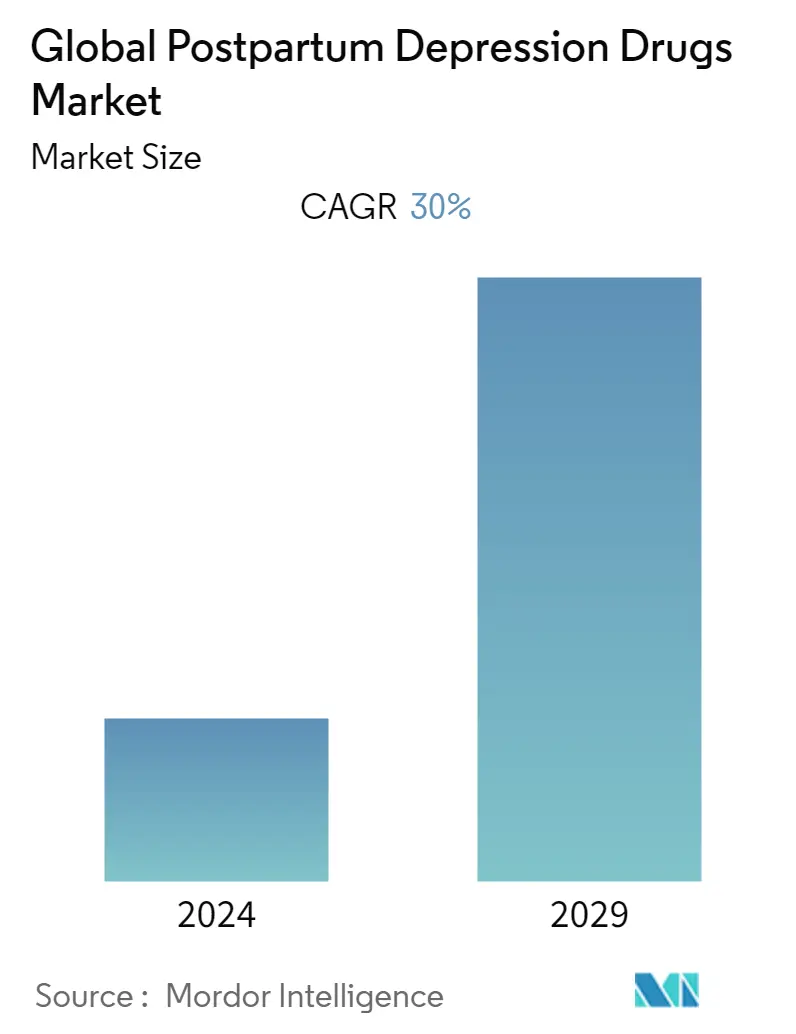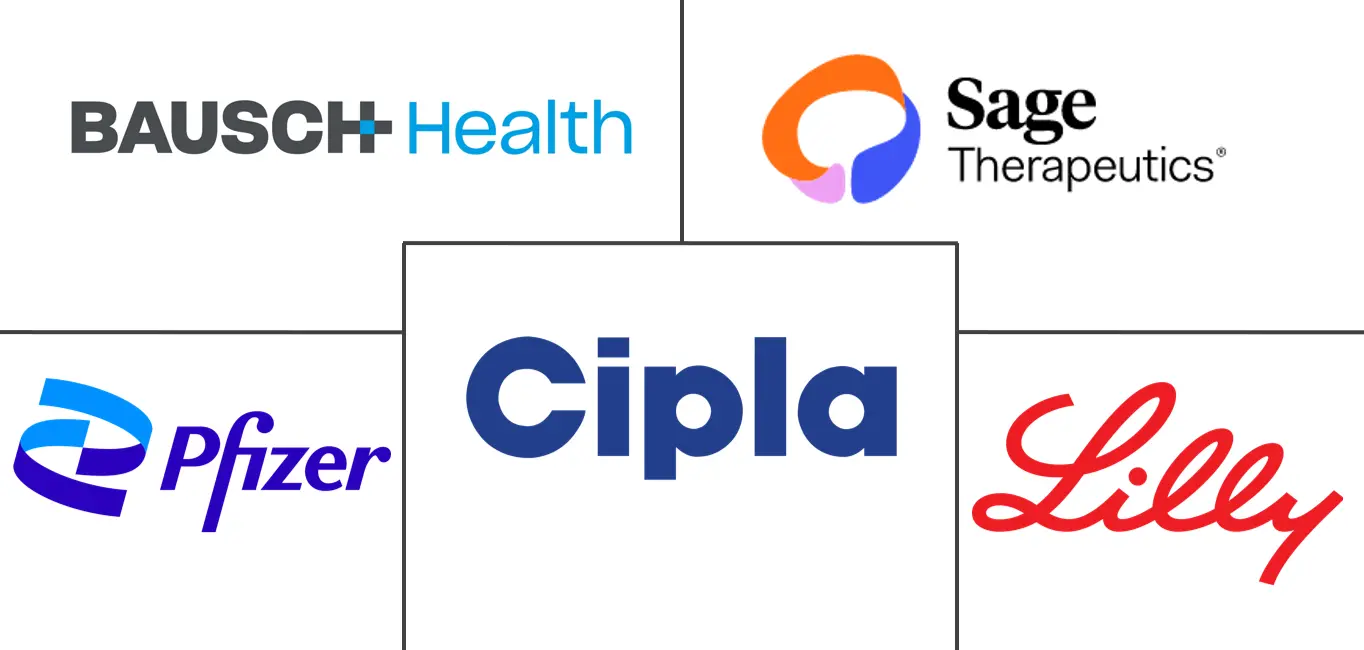Market Size of Global Postpartum Depression Drugs Industry

| Study Period | 2019 - 2029 |
| Base Year For Estimation | 2023 |
| Forecast Data Period | 2024 - 2029 |
| CAGR | 30.00 % |
| Fastest Growing Market | Asia-Pacific |
| Largest Market | North America |
Major Players
*Disclaimer: Major Players sorted in no particular order |
Postpartum Depression Drugs Market Analysis
Postpartum depression drugs are expected to register a CAGR of 30% during the forecast period (2022-2027).
Covid-19 had a significant impact on the postpartum drug market. Since the beginning of 2020, the Covid-19 pandemic has changed the healthcare system as well as affected the lifestyle of the population worldwide. People were stuck indoors for months and suffered mental health problems increasingly. The increased mental health issues and disorders increased the demand for depression medicines. Also, research shows that childbearing mothers were drastically affected by the lockdowns and closures. This increased the chances of postpartum depression among pregnant women. Additionally, increasing research on the impact of Covid-19 on the mental health of childbearing mothers and the prevalence of PPD increased during the pandemic. For instance, an article was published in the International Journal of Environmental Research and Public Health in February 2022, which aimed to estimate the influence of the COVID-19 pandemic on the prevalence of postpartum depression (PPD) and to summarize risk factors for PPD during the COVID-19 pandemic. As per the study findings, the COVID-19 pandemic was anticipated to have detrimental effects on maternal mental wellbeing among women after childbirth. Also, the study highlighted that the prevalence of PPD in the survey was higher than the incidents ranging from 10% to 22% during the COVID-19 pandemic. Therefore, the Covid-19 pandemic is predicted to have a significant demand for PPD drugs, impacting the overall growth of the market studied.
Factors such as a surge in product launches coupled with frequent product approvals and an increase in research and development activities are bolstering the growth of the PPD drugs market. Additionally, an increase in awareness about postpartum depression (PPD) is creating opportunities for the overall market studied. Additionally, clinical trials are increasing for developing new drugs for postpartum depression. For instance, as of 26th May 2022, 350 clinical trials have been registered for postpartum depression in the clinicaltrial.gov registry, among which 16 clinical trials were registered in 2020 and 17 were registered in the year 2021. This increasing number of clinical trials for developing drugs for PPD is hence, creating demand for new drugs, bolstering the overall studied market.
The increasing prevalence of PPD globally is increasing the demand for PPD drugs. The insights on the PPD prevalence and incidence worldwide show that there is a consistent rise in postpartum depression among childbearing mothers. A study was conducted to assess the prevalence of PPD and factors associated with it among a sample of mothers from the Central Region of Eritrea. The study was conducted in a regional health facility. This study was published online in October 2020 in BMC Public Health. As per the study, it is estimated that 20 to 40% of women in low-income countries experience depression during pregnancy or the postpartum period. The prevalence of PPD shows a wide variation, affecting 8-50% of postnatal mothers across countries. Hence, the prevalence of PPD globally is demanding innovative therapeutics for the PPD, driving the studied market growth.
Additionally, the recent rising development in the market is anticipated to rise the demand for PPD drugs in the future. For instance, In May 2022, a new quality improvement (QI) study from Cedars-Sinai suggested that Nurse education is the key to successfully screening women for postpartum depression, which affects 15% of mothers and moms with postpartum depression benefit from improved screening. These developments are predicted to drive the studied market growth.
Therefore, the insights mentioned above are expected to propel the PPD drugs market growth globally in the future. However, the excessive cost of PPD drugs is predicted to hinder market growth in the future.
Postpartum Depression Drugs Industry Segmentation
As per the scope of the report, postpartum depression, or PPD, is the depression associated with pregnancy or after childbirth. Several drugs are used for postpartum depression, and antidepressants are prescribed. The postpartum depression drugs market is segmented by Type (Postpartum Anxiety, Postpartum Post-Traumatic Stress Disorder, Postpartum Panic Disorder, Postpartum Psychosis, and Others), Treatment (Psychotherapy, Supplements, and Others), Route of Administration (Oral and Others), End Users (Hospitals and Clinics, Specialty Centers, and Others), and Geography (North America, Europe, Asia-Pacific, Middle East & Africa, and South America). The market report also covers the estimated market sizes and trends for 17 different countries across major regions, globally. The report offers the value (in USD million) for the above segments.
| By Type | |
| Postpartum Anxiety | |
| Postpartum Post-Traumatic Stress Disorder | |
| Postpartum Panic Disorder | |
| Postpartum Psychosis | |
| Others |
| By Treatment | |
| Psychotherapy | |
| Supplements | |
| Others |
| By Route of Administration | |
| Oral | |
| Others |
| By End Users | |
| Hospitals and Clinics | |
| Specialty Centers | |
| Others |
| Geography | ||||||||
| ||||||||
| ||||||||
| ||||||||
| ||||||||
|
Global Postpartum Depression Drugs Market Size Summary
The postpartum depression drugs market is poised for significant growth, driven by a combination of factors including increased awareness, research, and product development. The COVID-19 pandemic has notably impacted the market, as it exacerbated mental health issues among new mothers, leading to a heightened demand for postpartum depression medications. The pandemic's influence on maternal mental health has spurred research and clinical trials, contributing to the market's expansion. The prevalence of postpartum depression globally is on the rise, creating a pressing need for innovative therapeutics. This demand is further fueled by the increasing number of clinical trials and product launches aimed at addressing postpartum depression, which is expected to propel market growth in the coming years.
In North America, the postpartum depression drugs market is expected to dominate due to the high prevalence of the condition and increased awareness initiatives. The region has seen a surge in clinical trials and product approvals, which are driving market growth. Government and private sector initiatives are enhancing awareness and providing support for postpartum mental health, further boosting the market. The competitive landscape is characterized by the presence of major players such as Pfizer Inc., Sage Therapeutics, Inc., and others, who are actively engaging in collaborations and product launches. Despite the market's consolidation at a global level, local markets remain competitive, with ongoing efforts to address the mental health needs of new mothers.
Global Postpartum Depression Drugs Market Size - Table of Contents
-
1. MARKET DYNAMICS
-
1.1 Market Overview
-
1.2 Market Drivers
-
1.2.1 Surge in Product Launches Coupled with Frequent Product Approvals
-
1.2.2 Increase in Research and Development Activities
-
1.2.3 Increase in Awareness about Postpartum Depression (PPD)
-
-
1.3 Market Restraints
-
1.3.1 Excessive Cost of PPD Drugs
-
-
1.4 Porter's Five Forces Analysis
-
1.4.1 Threat of New Entrants
-
1.4.2 Bargaining Power of Buyers/Consumers
-
1.4.3 Bargaining Power of Suppliers
-
1.4.4 Threat of Substitute Products
-
1.4.5 Intensity of Competitive Rivalry
-
-
-
2. MARKET SEGMENTATION
-
2.1 By Type
-
2.1.1 Postpartum Anxiety
-
2.1.2 Postpartum Post-Traumatic Stress Disorder
-
2.1.3 Postpartum Panic Disorder
-
2.1.4 Postpartum Psychosis
-
2.1.5 Others
-
-
2.2 By Treatment
-
2.2.1 Psychotherapy
-
2.2.2 Supplements
-
2.2.3 Others
-
-
2.3 By Route of Administration
-
2.3.1 Oral
-
2.3.2 Others
-
-
2.4 By End Users
-
2.4.1 Hospitals and Clinics
-
2.4.2 Specialty Centers
-
2.4.3 Others
-
-
2.5 Geography
-
2.5.1 North America
-
2.5.1.1 United States
-
2.5.1.2 Canada
-
2.5.1.3 Mexico
-
-
2.5.2 Europe
-
2.5.2.1 United Kingdom
-
2.5.2.2 France
-
2.5.2.3 Germany
-
2.5.2.4 Italy
-
2.5.2.5 Spain
-
2.5.2.6 Rest of Europe
-
-
2.5.3 Asia-Pacific
-
2.5.3.1 India
-
2.5.3.2 China
-
2.5.3.3 Japan
-
2.5.3.4 Australia
-
2.5.3.5 South Korea
-
2.5.3.6 Rest of Asia-Pacific
-
-
2.5.4 Middle-East and Africa
-
2.5.4.1 GCC
-
2.5.4.2 South Africa
-
2.5.4.3 Rest of Middle-East and Africa
-
-
2.5.5 South America
-
2.5.5.1 Brazil
-
2.5.5.2 Argentina
-
2.5.5.3 Rest of South America
-
-
-
Global Postpartum Depression Drugs Market Size FAQs
What is the current Global Postpartum Depression Drugs Market size?
The Global Postpartum Depression Drugs Market is projected to register a CAGR of 30% during the forecast period (2024-2029)
Who are the key players in Global Postpartum Depression Drugs Market?
Pfizer Inc., Bausch Health Companies Inc., Lilly, Sage Therapeutics, Inc. and Cipla Inc. are the major companies operating in the Global Postpartum Depression Drugs Market.

